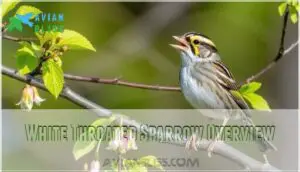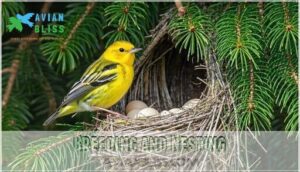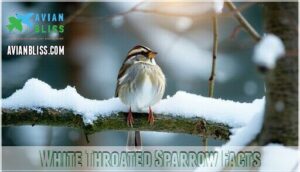This site is supported by our readers. We may earn a commission, at no cost to you, if you purchase through links.

This medium-sized songbird measures about 6-7 inches long with distinctive head stripes that come in two color variations – either crisp white stripes or warm tan stripes.
During breeding season, you’ll find them in Canada’s coniferous forests, but they migrate south for winter, often visiting backyard feeders across the United States.
Their clear, whistled song sounds like "Old Sam Peabody-Peabody-Peabody" and makes them easy to identify by ear.
These ground-feeding birds scratch through leaf litter for seeds and insects, displaying fascinating social behaviors that reveal surprising secrets about their unique breeding system.
Table Of Contents
- Key Takeaways
- White Throated Sparrow Overview
- Habitat and Distribution
- Behavior and Diet
- Breeding and Nesting
- Conservation Status
- White Throated Sparrow Facts
- Frequently Asked Questions (FAQs)
- What are the 4 genders of white-throated sparrows?
- Do white-throated sparrows come to bird feeders?
- How rare is a White-throated Sparrow?
- Why are white-throated sparrows important?
- Do white-throated sparrows come to feeders?
- How do white-throated sparrows care for their young?
- What is the lifespan of these birds?
- Do they migrate in large flocks?
- How often do they sing throughout the day?
- What does the tink call mean?
- Conclusion
Key Takeaways
- You’ll easily identify white-throated sparrows by their distinctive white throat patch, bright yellow spots above each eye, and clear whistled song that sounds like "Old Sam Peabody-Peabody-Peabody."
- You can attract these ground-feeding birds to your backyard feeders during winter months by offering millet and black oil sunflower seeds scattered below the feeder near dense shrubs.
- You’ll find two distinct color variations – white-striped birds with bold markings and tan-striped birds with muted tones – that represent fascinating genetic differences affecting their breeding behaviors.
- You should know their populations have declined 29% since 1970, making conservation efforts important as these birds face threats from habitat loss, climate change, and window collisions.
White Throated Sparrow Overview
You’ll find the White-throated Sparrow easy to identify with its bold white throat patch and distinctive head stripes that come in two color forms.
This medium-sized songbird measures 6-7 inches long and shows clear yellow patches near the eyes, making it stand out from other sparrow species.
Physical Characteristics
You’ll recognize a white throated sparrow by its distinct color pattern and size.
These medium-sized songbirds measure 6-7.5 inches with striking plumage patterns that vary between two morphs.
White-striped birds show bright yellow lores and crisp head stripes, while tan-striped individuals display muted tones.
**Two distinct forms exist – bright yellow patches and bold stripes versus softer, muted tones.
Their grayish bill color helps distinguish them from similar species.
Immature markings include streaky breast patterns that adults lack, and are part of the bird’s overall plumage patterns and distinct features.
Identification Features
When identifying a white throated sparrow, you’ll spot key features that make bird identification straightforward.
The distinctive white throat patch stands out against darker plumage patterns, while bright yellow lores create a striking color pattern near the eyes.
Notice the grayish bill color, which helps distinguish this species during sparrow identification.
Adult birds show clean breast patterns, but immature markings include streaky undersides.
These plumage morphs maintain consistent identifying features regardless of age.
Habitat also plays a role, as preferred environments vary for different species.
Plumage Variations
White-throated Sparrows showcase two distinct plumage morphs that you’ll encounter throughout their range.
Two striking color forms make every White-throated Sparrow encounter a delightful surprise in the field.
The white-striped morph displays bold white crown stripes and eyebrows, while the tan-striped morph shows warm tan markings in the same areas.
These morphs result from plumage genetics, not age or gender differences.
Morph determination follows stripe inheritance patterns, creating fascinating hybridization effects when different morphs breed together, influencing both appearance and morph behavior in offspring.
Habitat and Distribution
You’ll find White-throated Sparrows across a vast range that spans from northern Canada’s forests to the southern United States during winter months.
These adaptable birds breed in coniferous and mixed woodlands throughout Canada and the northern Great Lakes region, then migrate south to wintering grounds that stretch from southeastern Arizona to Florida.
Breeding Grounds
Across northern forests from Canada to New England, the Whitethroated Sparrow selects coniferous and mixed woodlands for breeding.
Males arrive first for territory establishment, claiming areas with dense understory vegetation. Females choose nest sites under shrubs or fallen logs, considering factors like protection and food availability.
Their breeding behavior focuses on clutch size optimization and fledgling success through careful parental care in these wooded sanctuaries.
Forest ecosystems support a wide range of species, requiring biodiversity and balance, which is crucial for maintaining healthy ecosystems.
Migration Patterns
When do these striped songbirds begin their epic journey across North America? Migration patterns reveal fascinating insights about White-throated Sparrow behavior and survival strategies.
These remarkable travelers follow three distinct routes:
- Eastern populations move from Canadian breeding grounds to southeastern wintering areas
- Central birds travel through the Great Plains corridor
- Western migrants reach Pacific Coast destinations
Migration triggers include decreasing daylight and temperature changes. Navigation strategies rely on magnetic fields and star patterns. Stopover ecology plays a vital role as birds refuel during long flights.
Climate impacts are shifting traditional migration patterns, forcing adaptive responses. Genetic pathways influence timing and destination choices for different populations.
Wintering Areas
During winter months, these sparrow birds abandon their northern breeding territories and head south seeking milder climates.
You’ll find white throat sparrows concentrated heavily across the southeastern United States, where winter habitats provide abundant food sources and shelter.
| Region | Winter Density | Key Features |
|---|---|---|
| Southeast US | Highest | Dense populations, ideal winter birds habitat |
| Eastern States | High | Urban adaptation common, reliable food availability |
| Southern Plains | Moderate | Climate impact creates suitable wintering grounds |
| Pacific Coast | Lower | Regional density varies with local conditions |
Behavior and Diet
You’ll observe White-throated Sparrows foraging on the ground beneath dense thickets, using their signature double-footed kick to scratch through leaf litter for insects and seeds.
These social birds often join mixed flocks during winter months, switching from a summer diet rich in insects to one dominated by seeds from weeds and grasses, which is a significant change in their diet.
Foraging Habits
You’ll find these sparrows have mastered the art of ground foraging, using a distinctive double-footed scratch to uncover hidden treasures beneath leaf litter.
Their white throat patches bob as they hop between feeding spots, demonstrating remarkable foraging techniques.
They often thrive on high quality seed during leaner times.
- Ground Foraging: Primary feeding occurs on forest floors using both feet simultaneously
- Seasonal Diet: Shifts from insects during breeding to seeds in winter months
- Insect Consumption: Pounces on crawling prey and catches flying insects mid-air
- Seed Preferences: Focuses on weed and grass seeds during colder seasons
- Foraging Techniques: Brief scratching motions reveal food sources under debris
Feeding Preferences
White-throated sparrows show clear seasonal diet preferences that reflect their feeding behavior throughout the year.
During breeding season, these birds consume mostly insects to provide protein for growing nestlings. Summer foraging techniques focus on catching crawling and flying insects using quick pouncing movements.
Winter brings a shift to preferred seeds from weeds, grasses, and berries. At bird feeders, they favor millet and black oil sunflower seeds, demonstrating their adaptable foraging strategies. You can easily find millet bird seed at online retailers.
Social Behavior
Beyond feeding patterns, you’ll notice these social birds form loose flocks during winter months.
Their flocking behavior creates safety in numbers while foraging together.
- Dominance hierarchies emerge within groups, with white-striped birds typically ranking higher than tan-striped individuals
- Territoriality peaks during breeding season when males aggressively defend nesting areas
- Social learning helps younger birds discover food sources through observation
These whitethroated sparrow interactions reveal complex avian behavior patterns that extend far beyond simple bird territory disputes.
Breeding and Nesting
White-throated sparrows start their breeding season when males return to establish territories one to two weeks before females arrive.
You’ll find these birds creating well-hidden nests on or near the ground, where females construct open cups from grass, twigs, and pine needles lined with fine materials, using grass to build their nests is not the only thing they do.
Nest Construction
Ground nesting is the name of the game for these smart birds.
You’ll see nests tucked under shrubs, well-hidden from prying eyes. Think grass, twigs, pine needles—those are the top nest materials.
Nests aren’t big, but they’re snug. Females do all the nest construction and even weave in bits of animal hair for camouflage.
To find appropriate materials, birds will often seek quality nesting twigs.
————–:
————–:
Incubation Period
Once the female White-throated Sparrow settles into her carefully constructed nest, the incubation process begins.
This dedicated mother takes sole responsibility for warming her precious eggs during the breeding season.
Here’s what happens during incubation:
- Incubation Length: The process lasts 11-14 days from start to finish
- Temperature Effects: Consistent warmth guarantees proper egg development
- Parental Roles: Only females incubate while males guard territory
- Hatching Success: Proper incubation leads to healthy chick emergence
- Nesting Habits: Females rarely leave eggs unattended during this critical period
Parental Care
Once incubation ends, both parents spring into action with their bird parenting duties.
You’ll observe cooperative breeding as male and female share feeding responsibilities equally. Their nestling diet consists exclusively of protein-rich insects during the first week.
After young fledge at 8-9 days, fledgling dependence continues for two more weeks. Post-fledging care involves teaching foraging skills while parents maintain protective watch over their vulnerable offspring.
Similarly, bluebird parents also clean the nest cavity to prevent parasites.
Conservation Status
You should know that White-throated Sparrow populations face significant challenges, with numbers dropping 29 percent since 1970 according to conservation groups.
This decline makes understanding their status essential for protecting these distinctive songbirds in North America, particularly their populations.
Population Trends
Understanding white-throated sparrow breeding success helps reveal troubling bird populations trends.
These sparrows have experienced severe decline causes, with North American Breeding Bird Survey data showing a 69% population drop since 1966.
Habitat loss and climate change drive these alarming numbers.
Here’s what the data reveals:
- Breeding populations plummeted from over 33 million in the 1970s to under 11 million today
- Eastern Canadian boreal forests show the most severe population losses due to environmental changes
- Bird monitoring programs track fewer sightings in New England and Great Lakes regions since 2000
- Bird conservation efforts focus on protecting remaining breeding territories before further decline
Bird ranges continue shifting northward as temperatures rise, forcing this sparrow species into smaller suitable areas.
Threats and Decline
Several factors threaten white-throated sparrows across their range.
Habitat Loss from urban development reduces breeding areas by 30% since 1980.
Climate Change shifts breeding timing, creating food mismatches.
Window Collisions kill one million birds annually.
Pesticide Use reduces insect prey by 40%, affecting chick survival.
Predation Impact from cats and nest parasites further strains bird populations, requiring urgent Conservation Strategies and bird monitoring.
Conservation Efforts
You can help protect white-throated sparrows through bird conservation programs that tackle habitat loss and climate change.
Population monitoring efforts track their decline while mitigation strategies reduce bird collisions and increase public awareness.
Bird conservation efforts focus on creating bird safety measures and supporting bird awareness campaigns that make real differences for these declining songbirds.
White Throated Sparrow Facts
Now you’ll discover fascinating details about this remarkable songbird that make it one of North America’s most interesting sparrows.
These facts reveal the White-throated Sparrow’s unique adaptations and behaviors that help it thrive across diverse habitats.
Vocalizations and Songs
You’ll recognize White-throated Sparrows by their distinctive whistled song that sounds like "Oh-sweet-Canada-Canada."
The Cornell Lab of Ornithology notes significant dialect variations across regions, with birds learning songs from local adults during vocal development.
Males sing complex melodies while females produce softer notes and alarm calls when threatened.
Migration and Nesting Habits
White-throated Sparrows follow predictable bird migration patterns, with males establishing territory two weeks before females arrive.
Migration triggers include changing daylight and temperature.
During bird nesting season, females gather nesting materials like twigs, pine needles, and deer fur to build ground-level nests.
Bird breeding success depends on clutch size of 3-6 eggs and fledgling survival rates through parental care.
Importance in Ecosystem
These small sparrows play essential roles that keep forest ecosystems healthy.
You can observe their impact through these key functions:
- Seed dispersal – They spread native plant seeds across woodland areas
- Insect control – They consume beetles and caterpillars that damage trees
- Habitat health – Their presence indicates strong forest conditions
As an indicator species, this bird species helps scientists monitor food web changes and bird conservation needs.
Interaction With Bird Feeders
During winter months, you’ll find White-throated Sparrows enthusiastically visiting backyard bird feeders.
These ground-feeding specialists prefer millet and black oil sunflower seeds scattered below feeders. Their double-footed scratching technique makes them entertaining backyard birds to watch.
Strategic feeder placement near dense shrubs accommodates their shy nature while providing excellent birdwatching opportunities for observing their unique feeding behavior.
To further enhance the feeding environment, consider visible open areas for increased bird attraction.
Frequently Asked Questions (FAQs)
What are the 4 genders of white-throated sparrows?
You’ll discover four distinct behavioral types based on two color morphs and gender combinations.
White-striped males, tan-striped males, white-striped females, and tan-striped females each show unique mating behaviors and territorial patterns in this fascinating sparrow species.
Do white-throated sparrows come to bird feeders?
Like a magnet draws metal shavings, your backyard feeder attracts white-throated sparrows seeking easy meals.
You’ll spot these birds scratching beneath feeders, enthusiastically devouring millet and black oil sunflower seeds throughout winter months.
How rare is a White-throated Sparrow?
White-throated Sparrows aren’t particularly rare – you’ll likely spot them during migration and winter months across much of North America, though their populations have declined roughly 29% since
Why are white-throated sparrows important?
Consider these feathered ecosystem engineers as nature’s pest control specialists – you’ll find they’re essential for maintaining forest health by consuming countless insects during breeding season while dispersing seeds across their range.
Their ground-foraging habits help control harmful insect populations naturally.
Do white-throated sparrows come to feeders?
Yes, you’ll often spot these feathered visitors at your feeders.
They’re particularly fond of millet and black oil sunflower seeds, making regular appearances especially during winter months when natural food sources become scarce.
They make these appearances because natural food sources are scarce during winter months.
How do white-throated sparrows care for their young?
Protective as a shield, both parents feed their nestlings insects exclusively, continuing care for two weeks after young leave the nest at 8-9 days old.
What is the lifespan of these birds?
You’ll discover that these little songbirds typically live around 9 years in the wild, though individual lifespans vary based on predation, disease, and environmental pressures they face throughout their lives.
Do they migrate in large flocks?
You’ll often spot white-throated sparrows traveling together during migration, though they don’t form massive flocks like starlings.
They prefer smaller groups, mixing with other sparrow species as they journey between breeding and wintering grounds, and they often travel with other sparrow species.
How often do they sing throughout the day?
You’ll hear white-throated sparrows singing most actively during dawn and dusk hours. They sing sporadically throughout daylight but peak during morning’s golden hour when they’re establishing territories and attracting mates.
What does the tink call mean?
Like a tiny bell that marks safe passage, the “tink” call tells others you’re just moving through, not looking for trouble.
It’s a contact call—letting flockmates know, “I’m here, all’s well, carry on.”
Conclusion
Like a reliable compass in the birdwatching world, the white throated sparrow offers consistent identification rewards for those who learn its key features.
You’ll find success spotting these birds by focusing on their distinctive white throat patches and yellow eyebrow spots during migration seasons.
Whether you’re hearing their clear "Old Sam Peabody" song or watching them scratch through leaf litter at your feeder, white throated sparrows provide excellent opportunities for both novice and experienced birders to sharpen their identification skills while enjoying nature’s seasonal rhythms.












